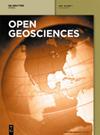带速度结构约束的徒步垂直地震剖面初至行进时间层析成像技术
IF 1.7
4区 地球科学
Q3 GEOSCIENCES, MULTIDISCIPLINARY
引用次数: 0
摘要
徒步垂直地震剖面测量(WVSP)通过初至采样获得初至走时与检波深度之间的关系,具有很高的可信度。这种关系可用于地震速度模型反演,以提高速度模型的准确性和合理性。在此,我们利用地面地震构造技术解释的层位和断层数据,提出了具有速度构造约束的 WVSP 初至速度模型。我们构建了基于沉积模式的地质结构和层序模型,以获得复杂的速度结构。此外,我们还在反演模型中引入了基于速度结构的平滑正则化项,以增强反演模型与地质规律的一致性,弥补基于平面结构的正则化项导致的反演精度降低。这种方法解决了基于平面结构的正则化项的局限性,使反演结果更加准确可靠。通过模拟分析,所提出的方法实现了 WVSP 初至速度反演,结果更接近实际速度模型。本文章由计算机程序翻译,如有差异,请以英文原文为准。
Walkaway vertical seismic profiling first-arrival traveltime tomography with velocity structure constraints
Walkaway vertical seismic profiling (WVSP) is known for its high level of credibility in obtaining the relationship between first-arrival traveltime and detector depth through first-arrival picking. This relationship can be utilized for seismic velocity model inversion to improve velocity model accuracy and rationality. Here, we present a WVSP first-arrival velocity model with velocity structure constraints, by utilizing layer and fault data interpreted by ground seismic structure technique. We constructed a geological structure and layer sequence models based on sedimentary patterns to obtain complex velocity structures. Furthermore, we introduced a smooth regularization term based on the velocity structure into the inversion model to enhance its consistency with geological laws and compensate for the reduced inversion accuracy owing to the regularization term based on flat structures. This approach addressed the limitations of the regularization term based on flat structures, resulting in more accurate and reliable inversion results. Through simulation analysis, the proposed method realized the WVSP first-arrival velocity inversion, with results being closer to those of the real velocity model.
求助全文
通过发布文献求助,成功后即可免费获取论文全文。
去求助
来源期刊

Open Geosciences
GEOSCIENCES, MULTIDISCIPLINARY-
CiteScore
3.10
自引率
10.00%
发文量
63
审稿时长
15 weeks
期刊介绍:
Open Geosciences (formerly Central European Journal of Geosciences - CEJG) is an open access, peer-reviewed journal publishing original research results from all fields of Earth Sciences such as: Atmospheric Sciences, Geology, Geophysics, Geography, Oceanography and Hydrology, Glaciology, Speleology, Volcanology, Soil Science, Palaeoecology, Geotourism, Geoinformatics, Geostatistics.
 求助内容:
求助内容: 应助结果提醒方式:
应助结果提醒方式:


